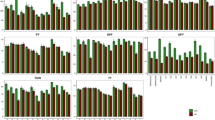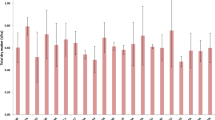Abstract
We examined the effects of drought stress on flowering time, grain yield, and agronomic traits using 10 upland-adapted rice genotypes, i.e. eight interspecific Oryza sativa L. ~ Oryza glaberrima Steud. (NERICA) lines and two Oryza sativa varieties—WAB56-104, the O. sativa parent of eight interspecific lines and IRAT 109, a drought-resistant variety as a check—under wet control and moderate drought-stressed conditions. Analysis of variance results for the 10 rice genotypes indicated that the effects of genotype (G) and drought stress (environment, E) were highly significant for tiller number, spikelet fertility, grain yield, straw dry-matter weight, and harvest index. Flowering was delayed by 1.7.10.7 (4.5 on average) days under drought condition compared with that under the wet control condition. Genotype (P < 0.001), drought stress (P < 0.001), and G ~ E interaction (P < 0.001) were highly significant with respect to days from seeding to 50% flowering (DTF50). DTF50 was significantly and negatively correlated with grain yield, yield components, and harvest index under drought-stress conditions. Of these, panicle number, total spikelet number, spikelet fertility, grain yield, and harvest index in drought-stressed rice genotypes were significantly and negatively correlated with DTF50 compared with those under the wet control condition. In conclusion, drought during the early vegetative stage inhibits most of the major agronomic traits by delaying flowering in upland-adapted rice genotypes.
Similar content being viewed by others
References
Africa Rice Center 2008. NERICA®: the New Rice for Africa — a Compendium. http://www.africarice.org/warda/guidecompend.asp
Alou IN, Steyn JM, Annandale JG, van der Lann M. 2018. Growth, phenological, and yield response of upland rice (Oryza sativa L. cv. NERICA 4®) to water stress during different growth stages. Agric. Water Manage. 198: 39–52
Bernier J, Kumar A, Ramaiah V, Spaner D, Atlin G. 2007. A large-effect QTL for grain yield under reproductive-stage drought stress in upland rice. Crop Sci. 47: 507–518
Bhattarai U, Subudhi K. 2018. Genetic analysis of yield and agronomic traits under reproductive-stage drought stress in rice using a high-resolution linkage map. Gene. 669: 69–76
Bocco R, Lorieux M, Seck PA, Futakuchi K, Manneh B, Baimey H, Ndjiondjop MN. 2012. Agro-morphological characterization of a population of introgression lines derived from crosses between IR 64 (Oryza sativa indica) and TOG 5681 (Oryza glaberrima) for drought tolerance. Plant Sci. 183: 65–76
Boojung H, Fukai S. 1996. Effects of soil water deficit at different growth stages on rice growth and yield under upland conditions. 1. Growth during drought. Field Crops Res. 48: 37–45
Ding X, Li X, Xiong L. 2013. Insight into differential responses of upland and paddy rice to drought stress by comparative expression profiling analysis. Int. J. Mol. Sci. 14: 5214–5238
Eberhart SA, Russell WA. 1966. Stability parameters for comparing varieties. Crop Sci. 6: 36–40
Fofana M, Sakariyawo O, Popogbe MO, Oyekanmi AA, Azeez JO, Adegbehingbe FT. 2018. Physiological and agronomic responses of four rice varieties to drought in the rainforest. Not. Sci. Biol. 10: 220–227
He H, Serraj R. 2012. Involvement of peduncle elongation, anther dehiscence and spikelet sterility in upland rice response to reproductive-stage drought stress. Environ. Exp. Bot. 75: 120–127
International Rice Research Institute (IRRI) 2013. Standard evaluation system for rice. 5th edition, IRRI, Manila. 36
Itoh T, Saigusa M. 2002. Yield survey method. In: T Hashiba, K Kanahama, Eds., A Manual of Experiments for Agriculture. Soft Science Publications, Tokyo, pp 32–36 (In Japanese)
Kameoka E, Suralta RR, Mitsuya S, Yamauchi A. 2015. Matching the expression of root plasticity with soil moisture availability maximizes production of rice plants grown in an experimental sloping bed having soil moisture gradients. Plant Prod. Sci. 18: 267–276
Kamoshita A, Babu RC, Boopathi NM, Fukai S. 2008. Phenotypic and genotypic analysis of drought-resistance traits for development of rice cultivars adapted to rainfed environments. Field Crop Res. 109: 1–23
Kumar R, Sarawgi AK, Ramos C, Amarante AM, Ismail AM, Wade LJ. 2006. Partitioning of dry matter during drought stress in rainfed lowland rice. Field Crop Res. 98: 1–11
Lafitte HR, Courtois B. 2002. Interpreting cultivar × environment interactions for yield in upland rice: Assigning value to drought-adaptive traits. Crop Sci. 42: 1409–1420
Lafitte HR, Ismail A, Bennett J. 2004. Abiotic stress tolerance in rice for Asia: progress and the future. “New directions for a diverse planet” Proc. 4th Int. Crop Sci. Congress. http://www.cropscience.org.au/icsc2004/symposia/3/6/1137_lafitte.htm #TopOfPage
Matsumoto S, Tsuboi T, Asea G, Maruyama A, Kikuchi M, Takagaki M. 2014. Water response of upland rice varieties adopted in Sub-Saharan Africa: a water application experiment. J. Rice Res. 2: 121. doi: https://doi.org/10.4172/jrr.1000121
Ndjionjop MN, Manneh B, Cissoko M, Drame NK, Kakai RG, Bocco R, Baimey H, Wopereis M. 2010. Drought resistance in an interspecific backcross population of rice (Oryza spp.) derived from the cross WAB56-104 (O. sativa) × CG14 (O. glaberrima). Plant Sci. 179: 364–373
Pantuwan G, Fukai S, Cooper M, Rajatasereekul S, O’Tool JC. 2002a. Yield response of rice (Oryza sativa L.) genotypes to different types of drought under rainfed lowlands. Part 1. Grain yield and yield components. Field Crop Res. 73: 153–168
Pantuwan G, Fukai S, Cooper M, Rajatasereekul S, O’Toole JC. 2002b. Yield response of rice (Oryza sativa L.) genotypes to drought under rainfed lowland. 3. Plant factors contributing to drought resistance. Field Crops Res. 73: 181–200
Saikumar S, Varma CMK, Saiharini A, Kalmeshwer GP, Nagendra K, Lavanya K, Ayyappa D. 2016. Grain yield responses to varied level of moisture stress at reproductive stage in an interspecific population derived from Swarna / O. glaberrima introgression line. NJAS Wagen. J. Life Sci. 78: 111–122
Singh B, Reddy KR, Redona ED, Walker T. 2017. Screening of rice cultivars for morpho-physiological responses to earlyseason soil moisture stress. Rice Sci. 24: 322–335
Swain P, Raman A, Singh SP, Kumar A. 2017. Breeding drought tolerant rice for shallow rainfed ecosystem of eastern India. Field Crops Res. 209: 168–178
Triola MF. 2015. Essentials of statistics 5th edition. http://wps.aw.com/aw_triola_stats_series/
Wopereis MCS, Kroff MJ, Maligaya AR, Tuong TP. 1996. Drought-stress responses of two lowland rice cultivars to soil water status. Field Crop Res. 46: 21–39
Xu AH, Cui KH, Wang WC, Wang ZM, Huang JL, Nie LX, Li Y, Peng SB. 2017 Differential responses of water uptake pathways and expression of two aquaporin genes to waterdeficit in rice seedlings of two genotypes. Rice Sci. 24: 187–197
Yue B, Xue W, Xiong L, Yu X, Luo L, Cui K, Jin D, Xing Y, Zhang Q. 2006. Genetic basis of drought resistance at reproductive stage in rice: Separation of drought tolerance from drought avoidance. Genet. 172: 1213–1228
Zhang C, Liu J, Zhao T, Gomez A, Li C, Yu C, Li H, Lin J, Yang Y, Liu B, Lin C. 2016. A drought-inducible transcription factor delays reproductive timing in rice. Plant physiol. 171: 334–343
Zu X, Ku Y, Wang Q, Chu P, Miao W, Wang H, La H. 2017. A new method for evaluating the drought tolerance of upland rice cultivars. Crop J. 488–498
Author information
Authors and Affiliations
Corresponding author
Rights and permissions
About this article
Cite this article
Kang, DJ., Futakuchi, K. Effect of Moderate Drought-Stress on Flowering Time of Interspecific Hybrid Progenies (Oryza sativa L. × Oryza glaberrima Steud.). J. Crop Sci. Biotechnol. 22, 75–81 (2019). https://doi.org/10.1007/s12892-019-0015-0
Received:
Revised:
Accepted:
Published:
Issue Date:
DOI: https://doi.org/10.1007/s12892-019-0015-0




